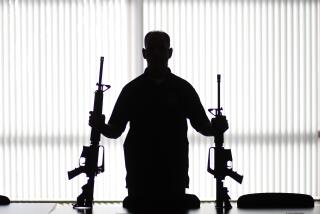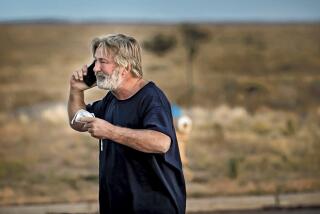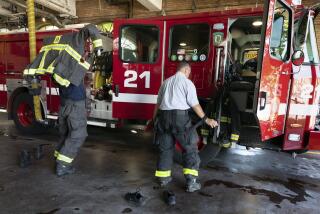Bitter Dispute Rages Around Bulletproof Vests : Body armor: Some protective clothing has been failing strict government tests. The issue is, who should set the standards?
- Share via
WASHINGTON — Slowly, deliberately, Richard Davis loads his .44-caliber magnum revolver. He grasps it with both hands, points it at his abdomen and stares ahead grimly. He fires; his body jerks with the impact.
A grin spreads over Davis’ weather-beaten face. “Nothing to it, folks!” he says with the satisfaction of a man who has shot himself more than 130 times in sales pitches for the bulletproof vests his company manufactures.
But for all the demonstrated confidence in his product, federal body armor standards that he and other manufacturers consider unreasonable are being imposed. The dispute has become so bitter that some police groups, for whom quality armor is a life-or-death matter, are asking Congress to intervene.
Sen. Dennis DeConcini (D-Ariz.) said he will introduce a bill to establish standards this month. Sen. Carl Levin, (D-Mich.) has asked Atty. Gen. Dick Thornburgh to mediate a compromise. “The increasing uncertainty can only hurt law enforcement officers,” Levin wrote Thornburgh.
The highly technical debate boils down to four issues: how such vests should be designed (particularly the amount of baffling needed to stop bullets), how the garments should be tested; who should set the standards and whether they should be voluntary or mandatory.
The National Institute of Justice, a branch of the Justice Department, has set quality guidelines for the vests and tested them since the early 1970s.
A vest is tested by mounting it on clay blocks firing at it from various ranges and angles. To meet NIJ standards, a vest must not only stop bullets; it must prevent them from making an excessively large dent in the clay. That’s because the impact of some rounds can damage internal organs even without penetrating the armor.
The standards were upgraded in 1987, to keep pace with changes in weapons and ammunition, said Lester Shubin, science and technology director for the institute. Suddenly, more than half the vests being tested were flunking.
The makers--including Davis’ employer, Second Chance Body Armor of Central Lake, Mich.,--cried foul. They said the only way to make sure their vest would pass every test would be to make it so thick and bulky that police wouldn’t wear them.
“Police officers don’t really want to wear the stuff, anyway. Give them any excuse to take it off and they will,” said Ed Bachner, ballistics manager for E.I. Du Pont de Nemours & Co., which makes Kevlar, the synthetic insulating material used in most bulletproof armor for the past 20 years.
“Police are dying because they aren’t wearing vests, not because the vests are bad,” Bachner said.
Surveys have found that only about 30% of police officers wear armor even though many departments require it, said George Austin Jr., national executive officer of the Fraternal Order of Police. Manufacturers say the number of wearers may be even lower.
Du Pont has documented more than 1,000 incidents in which wearing Kevlar body armor prevented death or serious injury, Bachner said. Most were shootings but many were stabbings or auto accidents, and there were even a couple of bull gorings.
A single vest retails for about $350, Davis said; he recently sold 4,000 of them to the Detroit police at a unit price of $175.
Larry Gates, executive director of the Personal Protective Armor Assn., said no vest has ever failed to protect a wearer from bullets it was designed to stop.
“They’ve performed flawlessly in the field, where it counts,” he said, “but in the laboratory tests under the NIJ standards, over half the vests fail. The test is flawed . . . but the NIJ won’t budge.”
Shubin said the vests have a good field record because the agency’s tests have kept inadequate products off the market.
“We believe a lot of their armor is marginal,” he said, “but we believe if it passes our standard, it’s going to work 100% on the street, and it has. We’re being faulted for being successful.”
Last year, Du Pont and the Personal Protective Armor Assn. established their own standards, which they say produce more consistent test results without sacrificing the wearer’s comfort.
Shubin and many police leaders aren’t reassured, however.
“I could put up with a little discomfort in exchange for extra protection,” said Austin, the FOP officer and a Poquoson, Va., beat cop. “And I’m the one out there on the street getting shot at.”
Police generally have sided with the government in the dispute, but not unanimously.
New York City Police Commissioner Lee Brown, who favors the NIJ standards, called the debate over vest design and testing procedures a “smoke screen.”
“The issue is who’s going to develop the standards,” Brown said. “I want them developed by someone who has no interest in selling a product.”
The Fraternal Order of Police wants Congress to assign a disinterested body, such as the NIJ, to set the standards, and the International Assn. of Chiefs of Police has taken a similar position.
The State Assn. of Chiefs of Police, a division of IACP, voted in April to oppose legislation and to ask the manufacturers and the NIJ to accept binding arbitration.
One vest manufacturer that supports government standards is Point Blank Body Armor of Amityville, N. Y. Its president, Richard Stone, said the industry’s primary motive is to protect the dominance of Kevlar.
“This is basically a commercial situation,” Stone said. “Du Pont’s had a virtual monopoly on body armor for 20 years, and they want to keep it that way.”
Du Pont’s Bachner disagreed. He said the controversy arose before the recent emergence of competitive synthetic fillers.
“I tell police if they can find a better product, they ought to buy it,” he said.






